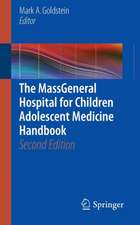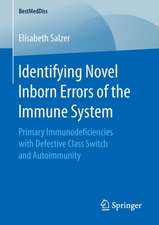Infant, Child and Adolescent Nutrition: A Practical Handbook
Autor Judy Moreen Limba Engleză Paperback – 28 iun 2021
Sections throughout focus on topics ranging from nutrient requirements, balanced eating patterns and common problems to cultural influences on food choices and guidelines on assessing growth and dietary intakes. Prevention and management of obesity and allergies are covered in separate chapters. The first 1000 days are given particular consideration with chapters on diets for preconception, pregnancy, milk feeding and complementary feeding during infancy. The chapter on nutritional treatments covers common conditions such as diabetes and Crohn's disease, as well as more intricate feeding regimes and tube feeding required for children with rarer diseases and syndromes.
New in this second edition are:
- Changes in in food allergy prevention and oral immunotherapy treatments.
- Causes and management strategies to deal with fussy and selective eating in toddlers.
- The importance of iodine in diets before and during pregnancy to improve children's cognitive abilities.
- Updated recommendations on vitamin D supplementation.
This second edition is an essential reading for students taking courses in nutrition and paediatric healthcare. It serves as a useful reference for individuals responsible for the nutritional intakes of children in primary care and community settings including early years practitioners, midwives, health visitors, school nurses and governors, social workers, paediatricians and general practitioners.
About the Author
Judy More BSc, RD, RN is a Paediatric Dietitian, Honorary Lecturer at the University of Plymouth, UK and Director of Child-nutrition.co.uk Ltd, London, UK.
| Toate formatele și edițiile | Preț | Express |
|---|---|---|
| Paperback (1) | 339.95 lei 3-5 săpt. | +25.67 lei 7-13 zile |
| CRC Press – 28 iun 2021 | 339.95 lei 3-5 săpt. | +25.67 lei 7-13 zile |
| Hardback (1) | 683.04 lei 6-8 săpt. | |
| CRC Press – 28 iun 2021 | 683.04 lei 6-8 săpt. |
Preț: 339.95 lei
Preț vechi: 357.84 lei
-5% Nou
65.06€ • 67.66$ • 54.44£
Carte disponibilă
Livrare economică 22 februarie-08 martie
Livrare express 08-14 februarie pentru 35.66 lei
Specificații
ISBN-10: 0367554550
Pagini: 308
Ilustrații: 70 Tables, black and white; 8 Line drawings, color; 10 Line drawings, black and white; 4 Halftones, color; 12 Illustrations, color; 10 Illustrations, black and white
Dimensiuni: 174 x 246 x 17 mm
Greutate: 0.57 kg
Ediția:2 ed
Editura: CRC Press
Colecția CRC Press
Cuprins
Preface vii
Author Bio viii
Section 1 Nutritional requirements and healthy eating
1 Nutritional requirements 3
2 Principles of a balanced nutritious diet for children over 1 year 17
3 Social and cultural influences on food choices 33
Section 2 Assessment of growth and nutritional intake
4 Measuring and assessing growth 49
5 Assessing nutritional intake 61
Section 3 Prenatal nutrition
6 Preconception and fertility 75
7 Pregnancy 81
Section 4 Infants: 0-12 months
8 Milk feeding 99
9 Complementary feeding 121
10 Common feeding problems in infancy 137
11 Preterm infants 147
Section 5 Preschool children: 1-4 years
12 Preschool children 1–4 years 161
13 Common nutritional problems in preschool children 177
14 Feeding preschool children in childcare settings 187
Section 6 School-age children
15 Primary school-age children 5–11 years 195
16 Nutrition for adolescents 205
Section 7 Nutrition for chronic conditions
17 Food hypersensitivity – food allergies and intolerances 219
18 Childhood obesity 233
19 Nutrition for children with chronic diseases and syndromes 245
Appendix 1: Function and Food Sources of Nutrients 267
Appendix 2: Growth Charts 273
Appendix 3: BMI and Waist Circumference Charts 283
Glossary 289
Index 293
Notă biografică
Recenzii
**Description**
This second edition of a U.K. pediatric nutrition handbook covers the most
up-to-date nutrition information in a more concise manner than typical
nutrition books. This previous edition was published in 2017.
**Purpose**
The purpose is to provide reliable nutrition advice in a practical manner. Since
nutrition information is ever evolving, this updated edition is needed to keep
up with current recommendations.
**Audience**
The book is intended for healthcare professionals in all disciplines who work
with children as well as all students in health-related fields who have an
interest in pediatrics. Since the content is U.K. focused, this book is best
used by a U.K. audience and this book certainly meets their needs. The author
is a pediatric dietitian in the U.K. and certainly is a credible authority.
**Features**
This second edition provides an update to some recommendations in the U.K.,
including the recommendation for vitamin D supplements in children. The book
contains seven sections and 19 chapters, with two to three chapters per
section. Most of the chapters include several tables, figures, and graphics.
The tables include U.K. reference intakes for vitamins and minerals as well as
typical food group distributions, healthy eating recommendations, and sample
meal plans. I was impressed with the diversity of food examples, but it makes
sense since a large number of ethnicities have migrated to the U.K. While the
U.S. does have similar diversity, U.S. books have not yet added the depth and
breadth that this book has. It certainly is something we should aspire to here.
The book also includes an excellent section on socioeconomic factors affecting
food choices, specifically religious food traditions, common food traditions
within religions, religious festivals observed by different religions, and
common traditional foods eaten by groups from different geographical regions
who have migrated to the U.K. Each of the above topics has a table with the
information. The last chapter includes nutrition for children with chronic
diseases and syndromes, including tube feeding, celiac disease, and diabetes.
Interestingly, there is a table in the diabetes section that highlights the
10-gram carbohydrate exchange list, which differs from our system of 15-gram
carbohydrate servings.
**Assessment**
While this book is meant for a U.K. audience, it certainly is an interesting
read. The topics regarding ethnicities and religions can be used by anyone in
the world. Here in the U.S., we have plenty of books that can meet the needs of
our students and healthcare professionals, such as <B><I>Samour and King's
Pediatric Nutrition in Clinical Care</I></B>, 5th edition, Konek and Becker
(Jones & Bartlett Learning, 2020), but this book serves its intended audience
well and is an affordable resource for nutrition professionals to gain insight
into U.K. practices.
-----------------------------------------------------------
Weighted Numerical Score: 71 - 3 Stars
Descriere
Infant, Child and Adolescent Nutrition: A Practical Guide, Second Edition, is an evidence-based, practical guide introducing readers to the theory behind optimal child nutrition. Containing practical advice on how to put that theory into practice, this new edition facilitates learning through case studies, key points, and learning activities. Divided into seven sections, chapters cover prenatal nutrition and nutrition throughout childhood from preterm babies to adolescents up to the age of 18.
Sections throughout focus on topics ranging from nutrient requirements, balanced eating patterns and common problems to cultural influences on food choices and guidelines on assessing growth and dietary intakes. Prevention and management of obesity and allergies are covered in separate chapters. The first 1000 days are given particular consideration with chapters on diets for preconception, pregnancy, milk feeding and complementary feeding during infancy. The chapter on nutritional treatments covers common conditions such as diabetes and Crohn's disease, as well as more intricate feeding regimes and tube feeding required for children with rarer diseases and syndromes.
New in this second edition are:
- Changes in in food allergy prevention and oral immunotherapy treatments.
- Causes and management strategies to deal with fussy and selective eating in toddlers.
- The importance of iodine in diets before and during pregnancy to improve children's cognitive abilities.
- Updated recommendations on vitamin D supplementation.
This second edition is an essential reading for students taking courses in nutrition and paediatric healthcare. It serves as a useful reference for individuals responsible for the nutritional intakes of children in primary care and community settings including early years practitioners, midwives, health visitors, school nurses and governors, social workers, paediatricians and general practitioners.
About the Author
Judy More BSc, RD, RN is a Paediatric Dietitian, Honorary Lecturer at the University of Plymouth, UK and Director of Child-nutrition.co.uk Ltd, London, UK.






















